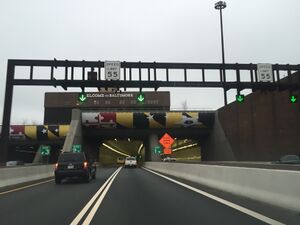نفق فورت مكهنري

| |
| Southbound tunnel, Bore 2 | |
| نظرة عامة | |
|---|---|
| المكان | Baltimore Harbor |
| الاحداثيات | 39°15′39.2″N 76°34′36.3″W / 39.260889°N 76.576750°W |
| المسار | |
| بدء | Locust Point |
| انتهى | Canton |
| Operation | |
| المالك | Maryland Transportation Authority |
| المرور | Automotive |
| Character | Highway |
| Toll | Passenger cars: $3 Maryland E-ZPass $4 non-Maryland E-ZPass $6 Video toll |
| العربات/يوم | 115,000 |
| التقنية | |
| الانشاء | 1980–1985 |
| الطول | 1.5 ميل (2.4 km) |
| No. of lanes | 8 |
| سرعة التشغيل | 55 أميال في الساعة (89 km/h) |
| الارتفاع الأدنى | 107 أقدام (33 m) below harbor water surface |
| Tunnel clearance | 13.6 أقدام (4.1 m) |
| العرض | 26 أقدام (7.9 m) |
| خريطة المسار | |
<mapframe>: لم يمكن تحليل JSON: خطأ صياغة
| |
The Fort McHenry Tunnel is a four-tube, bi-directional tunnel that carries traffic on Interstate 95 (I-95) underneath the Baltimore Harbor. Named for nearby Fort McHenry, the tunnel is the lowest point in the Interstate Highway System under water.[1]
Construction began in May 1980; the tunnel opened on November 23, 1985. Having consumed some $750 million (equivalent to $1.6 billion in 2022), it was the most expensive Interstate project until surpassed by the Big Dig in Boston.[2] اعتبارا من 2009[تحديث], it was used by 43.4 million vehicles annually.[needs update]
Tolls are collected in both directions. The toll for cars is $3 with a Maryland E-ZPass and $4 with another state's E-ZPass. Vehicles without an E-ZPass pay more, as do those with more than two axles—up to $45 for a 6+ axle vehicle without an E-ZPass.[3] All-electronic tolling using E-ZPass or toll-by-plate started in March 2020 as a result of the COVID-19 pandemic and was made permanent in August 2020.[4] A project to demolish the toll plaza and replace it with overhead gantries for open road tolling started in 2022.[5]
الموقع
The tunnel crosses the Patapsco River, just south of Fort McHenry; it connects the Locust Point and Canton areas of Baltimore City.
التصميم والإنشاء
Plans for a second crossing of the Baltimore Harbor that would become the Fort McHenry Tunnel began in the late 1960s. Early plans called for an 8-lane double-deck bridge to carry I-95 over the harbor just south of Fort McHenry. In 1975, plans were changed to a tunnel after it was determined that a bridge would hurt Fort McHenry's status as a national monument.
The state of Maryland originally intended to build the tunnel with a reinforced concrete box design, but plans were changed in February 1976 to use a steel tubular design after a dispute with the Federal Highway Administration. The tunnel was to be constructed using the immersed tube method, with prefabricated tubes sunken into the harbor.[6]
Construction began in May 1980 by K-R-T (a joint venture between Peter Kiewit Sons Company, Raymond International Builders, and Tidewater Construction Corporation), and was completed in November 1985. Ninety percent of construction costs were covered by federal funding, while 10 percent came from state funding. The tunnel consists of 32 tube sections, each 82 أقدام (25 m) wide and 42 أقدام (13 m) tall. The east and west approaches are 1،600 أقدام (490 m) and 3،200 أقدام (980 m) long, respectively.[7]
Opened on time and under budget, the tunnel closed a gap in I-95 through Maryland.[8] Soon after the Fort McHenry Tunnel opened, the nearby Baltimore Harbor Tunnel, which had opened to traffic in 1957, was extensively rehabilitated.
The Fort McHenry Tunnel continues to be a vital transportation link in the Mid-Atlantic region. After the Francis Scott Key Bridge collapsed on March 26, 2024, the tunnel became one of the primary alternate routes for drivers and trucks containing non-hazardous loads.[9]
See also
References
- ^ "The Interstate". Ginger Strand. Retrieved February 15, 2019.
- ^ DCRoads.net. "Fort McHenry Tunnel: Historic Overview". Accessed 2011-07-11.
- ^ "Maryland Toll Rates". Accessed 2023-01-31.
- ^ "All-Electronic Tolling Now Permanent at All MDTA Facilities Statewide in Maryland". Salisbury, MD: WBOC-TV. August 6, 2020. Retrieved August 6, 2020.
- ^ "CONSTRUCTION AT FORT MCHENRY TUNNEL (I-95) TOLL PLAZA WILL PROVIDE DRIVERS WITH HIGHWAY-SPEED ACCESS TO ALL-ELECTRONIC TOLLING | MDTA". mdta.maryland.gov. Retrieved 2022-08-16.
- ^ Kozel, Scott M. "Fort McHenry Tunnel". Roads to the Future. Retrieved March 22, 2019.
- ^ "Ft. McHenry Tunnel". Road Traffic Technology. Retrieved March 23, 2019.
- ^ "The Fort McHenry Tunnel." Fact sheet.
- ^ Mattu, Rohan (2024-03-26). "How to travel around the Francis Scott Key Bridge collapse in Baltimore: A look at the traffic impact and alternate routes - CBS Baltimore". www.cbsnews.com (in الإنجليزية الأمريكية). Retrieved 2024-03-26.
وصلات خارجية
Route map: Attached KML Error: KML file not found
KML file (edit • help)
|
- Fort McHenry Tunnel—history and technical info by Roads to the Future
- CS1 الإنجليزية الأمريكية-language sources (en-us)
- Short description is different from Wikidata
- Pages using gadget WikiMiniAtlas
- مقالات فيها عبارات متقادمة منذ 2009
- جميع المقالات التي فيها عبارات متقادمة
- Wikipedia articles in need of updating from January 2023
- All Wikipedia articles in need of updating
- Portal-inline template with redlinked portals
- Pages with empty portal template
- Attached KML errors
- Articles using KML not from Wikidata
- معابر نهر پتاپسكو
- أنفاق بلتيمور
- Toll tunnels in Maryland
- Tolled sections of Interstate Highways
- Interstate 95
- Tunnels completed in 1985
- Articles containing video clips
- Road tunnels in Maryland
- Immersed tube tunnels in the United States
- صفحات مع خرائط معطوبة
